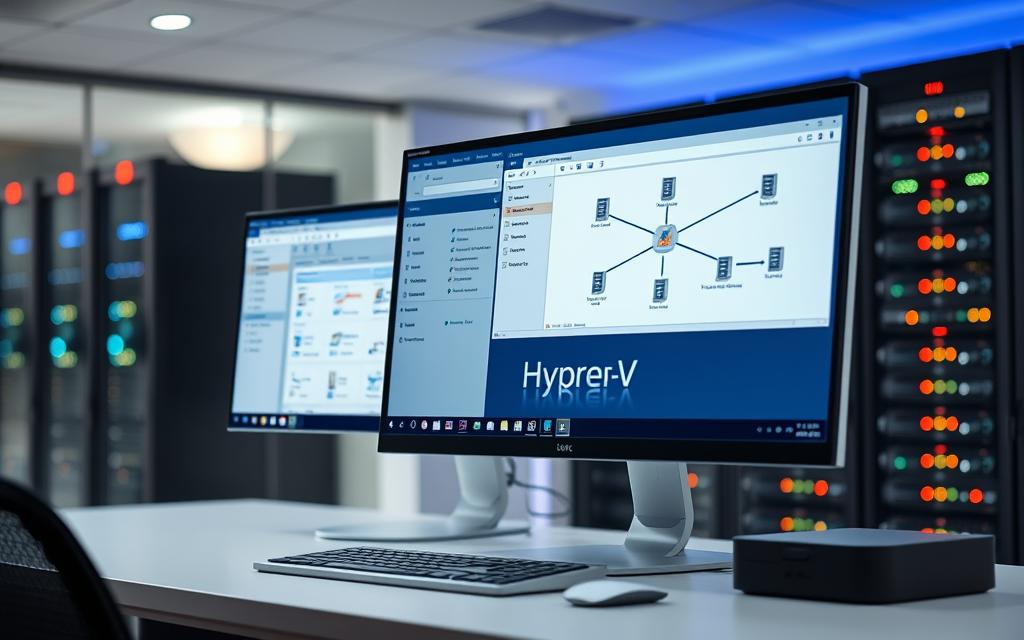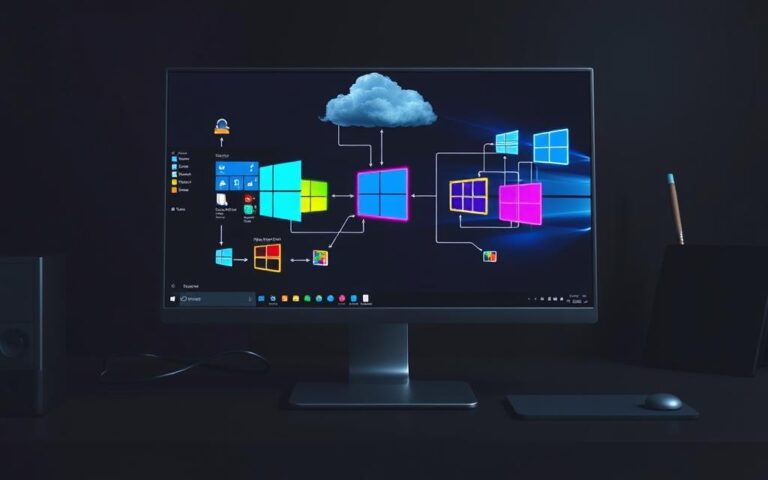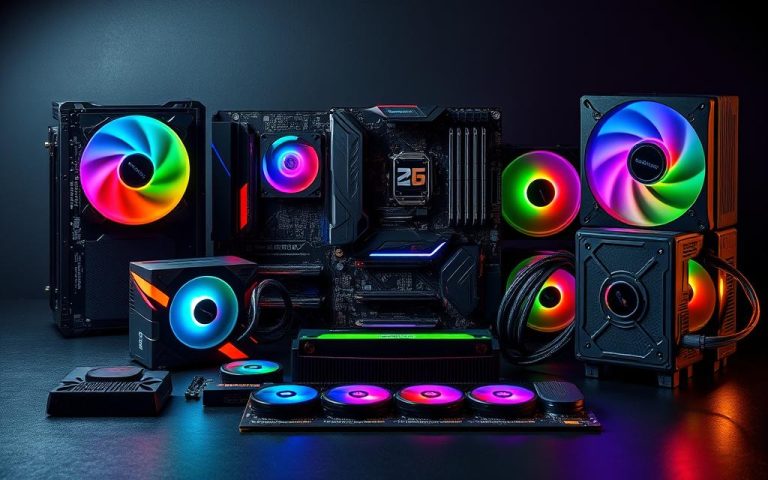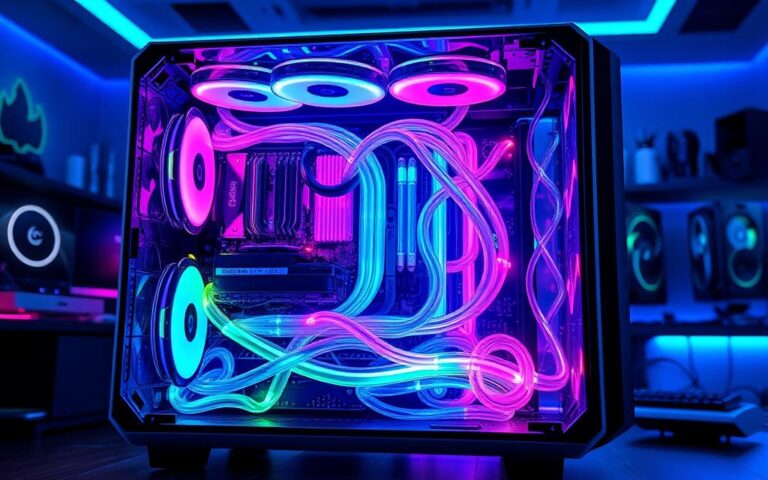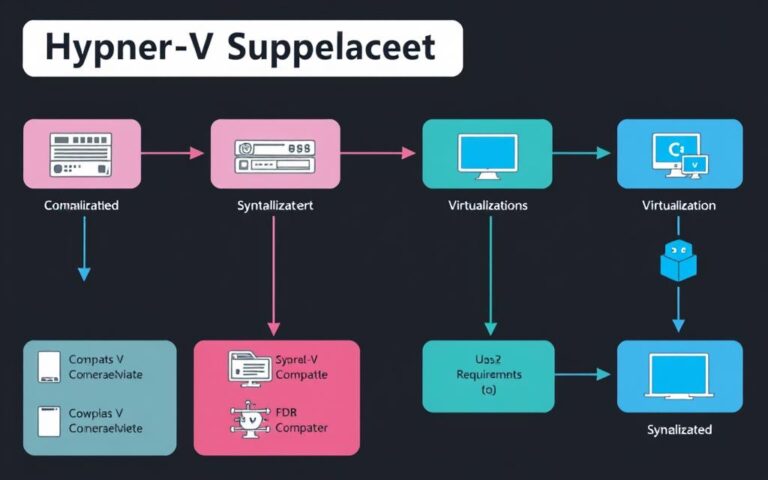Connecting Hyper-V Manager to Another Computer
In today’s fast-paced IT world, being able to connect Hyper-V Manager to another computer remotely is key. It boosts virtualization control and lets you manage multiple hosts with ease. Whether you’re working with recent Windows Server versions or Windows 11 and 10, understanding how to make these connections matters.
The rise of virtualisation technology means efficiency in management is crucial. Hyper-V Manager simplifies managing local and remote hosts. But, it’s vital to follow the right steps to keep connections secure and effective. This article will show you how to manage your Hyper-V setups from afar confidently.
Introduction to Hyper-V Manager and Remote Connections
Hyper-V Manager is key for managing virtual machines and Hyper-V hosts. It helps users look after hosts both nearby and far away. This makes managing tasks smoother. The Hyper-V Manager overview shows its role in helping organisations. It works to keep things efficient and secure.
Bringing together management tools helps make IT operations simpler. Hyper-V lets you have many virtual machines (VMs) on one server. You can find it in Windows Server 2016, 2019 and Microsoft Hyper-V Server 2016, 2019. It’s very useful for setting up or growing private clouds.
Understanding remote connections with Hyper-V is vital. You can connect from nearby using Remote Desktop. Or manage things from afar over the network. This makes your work more efficient. Plus, it boosts security by letting you handle VMs from any place without losing access.
Hyper-V helps keep businesses running smoothly by cutting downtime effects. It has great disaster recovery tools like Hyper-V Replica. Security features like shielding and secure boot keep virtual spaces safe. Using these tools, IT people can mix workloads and servers better. They use resources well, making operations resilient.
This approach lets organisations change as needed while keeping control over their virtual spaces. Knowing Hyper-V Manager and using remote connections well is key to managing IT well.
System Requirements for Hyper-V Manager
It’s vital to know the Hyper-V system requirements for Hyper-V Manager to work well. This tool works with many operating systems and needs certain hardware. Getting the right setup means great performance and a better experience.
Supported Operating Systems
Hyper-V Manager can be used with these Windows operating systems:
- Windows Server 2025
- Windows Server 2022
- Windows Server 2019
- Windows Server 2016
- Windows 11
- Windows 10
- Azure Local versions 23H2 and 22H2
Using the right operating systems compatibility is key. The Hyper-V Manager version should match the Hyper-V hosts. This makes sure all features work as they should.
Hardware Compatibility Requirements
The Hyper-V hardware requirements are essential for good virtualisation. Important specs include:
- A 64-bit processor with SLAT and virtual machine monitor mode extensions.
- At least 4 GB of RAM, more memory boosts performance.
- Support for virtualisation in BIOS or UEFI, like Intel VT or AMD-V.
Features like discrete device assignment need certain processor features like Intel EPT or AMD NPT. More key hardware needs are:
- Interrupt remapping
- DMA remapping
- Access Control Services (ACS) on PCI Express root ports in the chipset
Secure boot and TPM v2.0 for UEFI 2.3.1c help protect virtual machines. Meeting these hardware needs ensures Hyper-V runs smoothly.

How to Enable Remote Management of Hyper-V
To manage a Hyper-V server from afar, you must set it and your PC correctly. This lets you control your virtual machines without issues.
Setting Up Remote Management on Windows Server
First, make sure you’re in the Hyper-V Administrators and Remote Management Users groups. These roles let you manage things from a distance. Also, you should have local admin rights on the Hyper-V host. If you’re using VMConnect with “Enhanced Session” mode, being part of the Remote Desktop Users group is key. Start by tweaking your Windows Server settings. This includes turning on PowerShell Remoting and setting up CredSSP authentication for safe connections. You can find step-by-step instructions here.
Firewall Configuration for Remote Access
Getting your firewall settings right is vital for remote access. Make sure to open ports 135 for RPC and 5985 for WSMan. This helps your PC and the Hyper-V server talk without trouble. If you have extra hardware firewalls, you might need to tweak those settings too. Skipping this step could make connecting very hard.
Steps to Connect Hyper-V Manager to Another Computer
Connecting to another computer with Hyper-V Manager improves your control over virtual machines. It lets you manage resources on many systems easily. The right steps make shifting between local and remote connections smooth. This ensures your operations work well.
Connecting to a Local Computer
To connect to a local computer, first right-click Hyper-V Manager and pick “Connect to Server”. Then, select “Local computer” for better Hyper-V local management. Doing this lets you directly access the virtual machines on your local server. If you face problems, check if Hyper-V is installed right and look at user permissions to fix issues.
Managing Remote Hyper-V Hosts
To manage remote Hyper-V hosts, type the server’s hostname or IP in Hyper-V Manager. This manage remote Hyper-V ability is great for IT pros managing virtual environments from afar. Make sure remote management and security are set up right on all systems. Updating Hyper-V and Windows systems is key to preventing connection problems.
Keep your systems updated and follow best practices for top performance. Set passwords, change computer names, and check remote desktop access. If you run into connection problems, look into Virtual Machine Management service and authentication issues. These can stop remote host connections.
Check out this page for more on cookie usage and settings. Keeping everything correct and up-to-date ensures smooth virtual machine management across different places.
Common Connection Issues and Resolutions
Connecting to Hyper-V Manager can be tricky due to various challenges. Users may face authentication issues or permission problems. These problems often come from wrong credential settings or not having enough rights. Trying to access Hyper-V hosts without success can make managing virtual machines hard.
Authentication and Permissions Challenges
Authentication errors usually happen if the user isn’t in key groups like Administrators. It’s important to check that account details are right for the remote host. To fix permission issues, it helps to take systematic steps:
- Make sure the user account has the right permissions.
- Check group memberships to ensure access to needed rights.
- Confirm that passwords are up to date and not expired.
- Review any recent changes in user roles that might affect access.
Network Configuration Troubleshooting
Network settings play a big role in connecting to Hyper-V Manager. To troubleshoot, admins should check settings that might block remote access. Problems can come from:
- Firewall settings blocking needed communication.
- Wrong network settings leading to disconnects.
- Issues with having multiple network cards.
- Resource usage that affects performance.
For better communication with Hyper-V host, admins should check:
- The servers are updated with the latest software.
- Network protocols and settings for stable connections.
- Storage indicators like RAID setups for better resource use.
| Error Message | Description |
|---|---|
| Cannot connect to the virtual machine | General connection failure to the VM. |
| Unable to open the search page | Issue with the search functionality. |
| This Page can’t be displayed | Potential network issues or service not available. |
| An internal error has occurred | A generic internal error that needs more checking. |
| Error code 80070008 | Windows Update issue indicating a possible misconfiguration. |
| 0x80070035 | Network path not found, showing connection issues. |
Systematically fixing these problems is crucial for successful connections. For information on how personal data is handled, check the privacy policy to understand the rules and safety measures.
Conclusion
Connecting Hyper-V Manager to another computer is key for top Hyper-V management. Knowing the requirements and how to set up is crucial. It improves the whole virtual system and makes operations smoother. Also, knowing how to fix common problems helps keep remote connections without trouble.
It’s vital to know what new versions offer, like better user sessions with shared clipboard and USB features. But, it’s also important to know about issues with certain Windows Server versions, like 2019. Set up Active Directory properly and check security settings to avoid most connection problems.
In the end, knowing the best ways to connect and manage is empowering for IT pros. It forms a strong and safe virtual space. With the right tools and know-how, such as using the Windows Admin Center, companies can use Hyper-V fully. This brings them closer to their virtualisation aims confidently.
FAQ
What is Hyper-V Manager?
Hyper-V Manager is a Microsoft tool. It lets users manage virtual machines and Hyper-V hosts. This includes both local and remote servers.
How do I enable remote management on Hyper-V?
To start, open Server Manager on Windows Server. Then, go to Local Server and turn on remote connections. Also, make sure PowerShell Remoting is active for secure commands.
What hardware specifications do I need for Hyper-V?
Check that your hardware has the right CPU, enough memory capacity, and suitable storage options. These are needed for good virtualisation.
What are the common issues when connecting to remote Hyper-V hosts?
Issues often include authentication errors, lack of permissions, and network configuration mistakes. Make sure user account credentials and permissions are correct.
Which operating systems support Hyper-V Manager?
Hyper-V Manager works with Windows Server versions 2025, 2022, 2019, 2016, Windows 10, and Windows 11. It’s important to check for compatibility with your host.
How do I troubleshoot network configuration issues for Hyper-V Manager?
Start by checking network settings. Then look at firewall configurations. Make sure the right routing protocols are set for the local computer and Hyper-V hosts to talk.
What firewall settings are necessary for Hyper-V remote management?
Open ports 135 (RPC endpoint mapper) and 5985 (WSMan) in Windows Firewall. For hardware firewalls, you might need more setup rules.
How can I connect to a local computer using Hyper-V Manager?
Right-click Hyper-V Manager and pick “Connect to Server”. Then select “Local computer”. This makes managing the local Hyper-V host easy.

